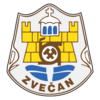Zvečan
Zvečan/ Zveçan | |
|---|---|
Municipality and city | |
| Template:Lang-sq Template:Lang-sr | |
 The town of Zvečan with Zvečan Fortress | |
| Country | Kosovo[a] |
| District | District of Mitrovica |
| Government | |
| • Mayor | Dragiša Milović |
| Area | |
• Total | 123 km2 (47 sq mi) |
| Elevation | 461 m (1,512 ft) |
| Population (2014) | |
• Total | 7,341 |
| • Density | 60/km2 (150/sq mi) |
| Time zone | UTC+1 (CET) |
| • Summer (DST) | UTC+2 (CEST) |
| Postal code | 38227 |
| Area code | +381 28 |
| Car plates | 02 |
| Website | Municipality of Zvečan |
Zvečan (Template:Lang-sr, Zvečan, Template:Lang-sq) is a town and municipality in the Mitrovica district of Kosovo.[a] It is a part of North Kosovo, a region with an ethnic Serb majority that functions largely autonomously from the remainder of the ethnic-Albanian-majority Republic of Kosovo. The municipality covers an area of 104 km2 (40 sq mi), and consists of 35 villages.[1] As of 2014, the municipality has a population of approximately 7,341.[1]
History

The town of Zvečan is located near Mitrovica. It was mentioned for the first time in connection with the border clashes between the Serbs and Byzantines between 1091 and 1094. There is also an inscription that Grand Prince Stefan Nemanja, after the victory over the Byzantines in 1170, ordered that a prayer for the successful outcome of the battle be held in the church of St. George at Zvečan.
In the 13th and 14th centuries Zvečan was one of the royal residences of the Serbian court. Queen Theodora died there in December 1322, and nine years later her husband, Stefan Uroš III was imprisoned and strangled there.[2] First the Musić, then the Vojinović noble family, held the fortified city and region during the Serbian Empire of Uroš V (r. 1355–1371). As imperial power collapsed Zvečan was in a disputed zone being held by Miloš Pović in 1370 but claimed by Nikola Altomanović.[3]
In 1389, after the Battle of Kosovo, it was integrated into the Ottoman Empire and later became part of the Sanjak of Novi Pazar.[4] From 1878 to 1908 it, along with the rest of the Sanjak, was administered by the Austro-Hungarian Empire as a result of the Congress of Berlin. But in 1908 it was returned to Turkey.
On the highest spot, i.e., the Upper Town, there are remains of the church of St. George, cistern and the main octagonal tower. The ramparts of this part of the fort are reinforced by massive towers. The main entrance to the town was on the western side.
Economy
The largest employer in Zvečan is the lead and zinc melting factory “Trepča”. Its large smokestack is with 306 metres the tallest structure in Kosovo. Due to the serious environmental pollution from the factory, however, UN and KFOR shut it down and the only ongoing operation is alloy production for batteries and battery recycling. Once employing up to 4,000, the very low operations of “Trepča” has had a devastating effect on the local economy. Today, in the municipality only about 500 people are working at 60 small private companies and 150 shops.[1]
Culture and education
The Faculty of Arts, part of the University of Pristina at Mitrovica, is situated at Zvečan.
Zvečan has hosted annually two international music festivals: The North City Jazz & Blues Festival,[1][5][6][7][8][9][10][11] and international rock festival Overdrive,[12] as well as international art colony Sokolica[13] and children song festival Cvrkuti sa Ibra (Chirrups from the Ibar River).
The Zvečan Fortress and Sokolica Мonastery, both from the Middle Ages, have been located in the Zvečan area.[1]
Demographics
In November 2005, it was estimated that the municipality was 95% Serb, with only 4 Albanian families in the area.[citation needed] According to 2006 estimates, the municipality of Zvečan had a population of 16,600 people.[citation needed] As of 2008, the municipality has a population of approximately 17,000 inhabitants, of which ca. 16,050 (ca. 94%) are Serbs. Some 350 Albanians are concentrated in the villages of Boljetin, Lipa and Žaža, with 80 Kosovo Albanian families having returned to the municipality since 2000. A small number of other minorities also reside in the municipality. About 4,000 Kosovo Serbs are located in the municipality as Internally displaced persons (IDPs) as well as 250 refugees from Croatia.[1]
See also
Notes and references
Notes:
References:
- ^ a b c d e f OSCE Mission in Kosovo: Municipal profile of Zvečan, April 2008. – Retrieved on 15 May 2009.
- ^ Bury, John Bagnell et al. (eds.) (1923) The Cambridge Medieval History Macmillan, New York, p. 539, OCLC 271025434
- ^ Rade Mihaljčić, Kraj srpskog carstva, pp121-2
- ^ Map of Turkey and Greece 1847, from Sharpe's Corresponding Maps Chapman and Hall, London
- ^ ''Vreme'' No. 853. Vreme.com. Retrieved on 29 November 2011.
- ^ ''Kosovska Mitrovica Live''. Kosmitrovica.blog.rs. Retrieved on 29 November 2011.
- ^ ''Glas javnosti'', June13, 2005. Arhiva.glas-javnosti.rs. Retrieved on 29 November 2011.
- ^ Asocijacija medija , May 2007 Archived 2008-10-10 at the Wayback Machine
- ^ Telekom, 16 May 2007[dead link]
- ^ Trident
- ^ ''Glas javnosti'', 5 June 2003. Arhiva.glas-javnosti.rs. Retrieved on 29 November 2011.
- ^ Blic, 9 October 2006[dead link]
- ^ Krstarica, 22 August 2007[dead link]
External links
- Municipality of Zvečan at the Republic of Kosovo
- Municipality of Zvečan Official Website
- Profile of Zvečan
- The Faculty of Arts of Pristina
- North City Jazz & Blues Festival


